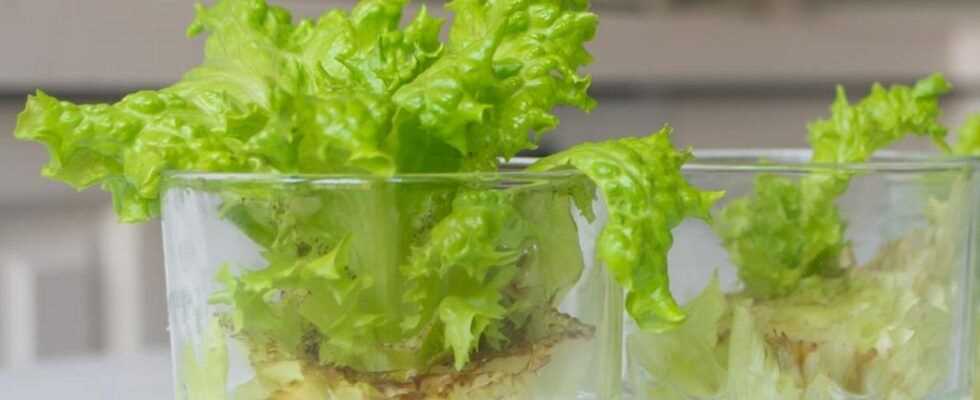Regrow
Just keep growing vegetables and herbs
From old to new: If the lettuce stump is in water, young leaves will grow back.
© Mehriban A / Shutterstock.com
With regrow, plant residues form the basis for growing vegetables and herbs again. These plants are particularly suitable.
Spend money on fruit, vegetables or herbs every time you go to the supermarket or the greengrocer? It doesn’t have to be. If you have pots, soil and some space on the windowsill, you can easily grow plants at home. In his book “Regrow für Einsteiger” (mvg), Guillaume Marinette explains how new plants are created from the remains of plants. The so-called “regrow” can actually be applied to all plants. Instead of ending up in the garbage, roots, stems and the like find a place in a water container. However, it should be noted that, especially with fruits, it can take a long time for an old fruit to turn into a new one.
If you put an avocado seed in the ground, you can look forward to a beautiful plant afterwards. You can only get beautiful fruit after cross-pollination. “So you would need two trees,” explains the author. Other fruit pits could one day grow into a tree that bears its own fruit – but this usually takes a long time. As an example: With peaches this takes an average of six to seven years, with mangoes it takes around ten years for the plant to produce its maximum yield. If you want something from your regrow project as soon as possible, you should therefore rely on vegetables and herbs. These five plants are particularly easy and quick to breed.
Spring onion
A very easy regrow candidate is the spring onion. It can be harvested two weeks after sowing at the earliest – even a full spring onion, because the harvest is similar to the original. There are two ways of regrowing vegetables: in a glass of water or in a pot full of soil. However, if you want more flavor and more nutrients, you should make the effort and put the spring onion in the ground.
This is how it works: When you buy it, it is important to buy spring onions that still have their roots. Cut off the lower part including the root with a knife. It should be around two inches long. Put the cut pieces in a glass with not too cold water. The plants stay in it for around a week. Change the water every two days. The spring onion is getting its first shoots? Then it can move into a pot of soil. It is important to note that the lower part of the plant is covered with soil. The young spring onions feel particularly comfortable in a bright place – outdoors or indoors. Just water regularly and the plant will continue to grow and thrive.
Romaine lettuce
The romaine lettuce, also called romaine lettuce, is one of the plants that are particularly easy to grow. In contrast to the spring onion, however, the lettuce only grows back once. When regrowing, the lettuce is a little smaller than the original. However, it does not lose any of its taste. Once you’ve started driving, the romaine lettuce develops very quickly. This is why hobby growers shouldn’t miss the time to harvest the new leaves before they bloom.
This is how it works: Cut the lettuce stump to about five centimeters, put it in a small container and pour water over it. Then place the vessel in a sunny place for five to ten days and change the water every two days. If the first roots sprout, the stump ends up in a pot of potting soil – but not too deep so that the leaves can grow freely.
Basil, mint and thyme
The popular culinary herbs basil, mint and thyme are ideal for breeding. Rearing them is very easy. Once the plant has grown back, the individual leaves or stems can be picked. Basil and mint in particular grow quickly. The plants feel good outside in summer, but they also grow back without any problems inside.
This is how it works: All kinds of herbs are grown in the same way. First choose a stem, cut it straight off with scissors and remove the lower leaves so that only the top leaves are left. Then place the stem in a glass with water that is not too cold. The plant will grow back in a bright place but without direct sunlight. Supply the herbs regularly with fresh water, preferably every two days. If roots form, the plants move to a pot with soil.
